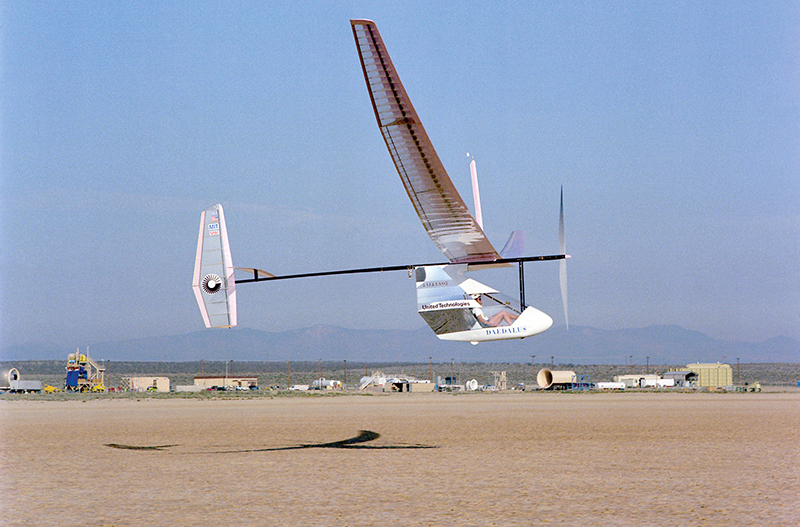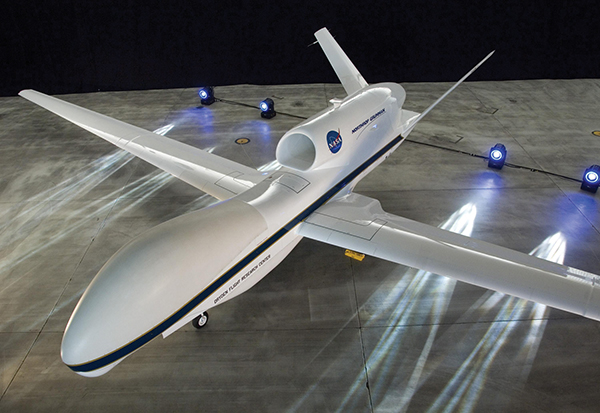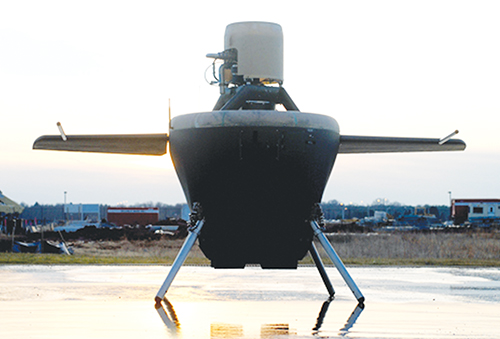
Technologies Advance UAVs for Science, Military
Originating Technology/NASA Contribution
Greek mythology tells of the inventor Daedalus using wings of his own fashioning to escape from imprisonment on the island of Crete. In 1988, a similar adventure was launched, though in this case carbon-fiber composites, gears, and driveshafts featured instead of wax and feathers.
A year earlier, a group of students, alumni, and professors from the Massachusetts Institute of Technology (MIT) gathered at Dryden Flight Research Center to begin a series of test flights for what they hoped would be a record-setting effort. Inspired by the Greek myth, the team built and tested three lightweight, human-powered aircraft designed to reenact Daedalus’ (according to the tale) 115-kilometer flight. After numerous test flights of the three aircraft (and one crash), the 69-pound Daedalus 88 launched from Crete in April 1988. Powered only by the pedaling of the pilot, a Greek champion cyclist, the aircraft flew nearly 4 hours and 199 kilometers before winds drove it into the sea just off the coast of the island of Santorini. (If this calls to mind the demise of Daedalus’ son Icarus, do not worry; the pilot swam to shore.)
Setting distance and duration records for human-powered flight that are still unmatched today, the Daedalus project provided NASA and the MIT team the opportunity to explore new technologies for lightweight aircraft and high-altitude, long-duration flight. Also from this effort came the kernel of a company that—with the help of NASA partnerships—is producing some of the world’s most advanced aviation technologies.
Partnership
In 1989, John Langford founded Aurora Flight Sciences Corporation in a small office in Alexandria, Virginia. Langford had managed the Daedalus project and saw great potential in applying the technologies developed for that effort to the innovation of high-altitude unmanned aerial vehicles (UAVs) for global climate change research. Almost immediately, Aurora established a pattern of partnership with NASA that continues today.
“NASA has been a critical supporter of Aurora from day one,” says Langford. The company has engaged in numerous Small Business Innovation Research (SBIR) and Small Business Technology Transfer (STTR) projects with the Agency, beginning with its initial Ames Research Center SBIR, for the development of a fuel cell-based high-altitude propulsion system, up until its most recent contract in 2009 to create aspirated compressors for a high-altitude, long-endurance (HALE) concept engine for Glenn Research Center. These partnerships have provided opportunities for Aurora on multiple fronts, Langford says.
“There is a technology development function, a personnel development function, and also a collaboration function through SBIRs and STTRs,” he explains. “We have bright new talent, and these programs provide a great way for people to explore new ideas.”
Aurora, now headquartered in Manassas, Virginia, has also worked with NASA on several unique initiatives. The company developed the Perseus A, Perseus B, and Theseus test bed UAVs for NASA’s Environmental Research Aircraft and Sensor Technology (ERAST) program. Designed to encourage the advancement of cost-effective UAVs for HALE science missions, ERAST was instrumental in the creation of new UAV technologies like the Predator B, known as the Altair in its NASA science mission version and as the MQ-9 Reaper for the military. Aurora also designed and created a series of UAVs for potential long-range science missions on Mars.
In addition, a Space Act Agreement with Goddard Space Flight Center and West Virginia University was significant to Aurora’s commercial activities today. Through the partnership, Aurora developed low-cost composite materials manufacturing capabilities and opened a manufacturing facility in West Virginia. These outcomes enabled Aurora to provide cost-efficient airframe parts for the Teledyne Ryan (now Northrop Grumman) Global Hawk UAV, designed for the U.S. Air Force.
Product Outcome
Aurora now has 350 employees and has facilities in Mississippi and Massachusetts, in addition to its West Virginia and Virginia operations. The company employs 160 people in its NASA-enabled West Virginia plant, and about one-third of Aurora’s work force is dedicated to the company’s Global Hawk efforts. Aurora now supplies all the composite structures for Global Hawk, save for the wings.
“This is an example of economic development done right,” Langford says. “You want to build up the economy across the country, and this was a move that NASA participated in that has been very successful.”
The partnership has also allowed Aurora to contribute to the use of UAVs for scientific endeavors; NASA’s two Global Hawk aircraft began long-duration science missions over the Pacific Ocean in 2010 as part of the Agency’s Global Hawk Pacific Mission.
“We are very proud of the fact that parts of those planes were built in our West Virginia facility,” Langford says.
Aurora’s expertise in advanced aviation development—cultivated in part through its NASA work—has led to the creation of unique robotic aircraft that are providing entirely new takes on UAV design and function. Aurora’s GoldenEye and Excalibur aircraft are both vertical takeoff and landing vehicles with science-fiction looks. The GoldenEye 50 and the larger GoldenEye 80 are ducted-fan aircraft designed to provide highly portable surveillance for military applications. Excalibur is an armed tactical UAV that takes off on one side and then rolls over for mission mode, protecting its sensors from any dust kicked up by its propulsion system.
“A lot of aircraft missions are not involved with carrying people, and when you take the people out of the equation, it completely changes the design space,” explains Langford. “GoldenEye and Excalibur are examples of designs that have no analog in manned aircraft.”
The popularity of UAVs has risen dramatically in recent years, Langford says. “Ten years ago, all the UAVs in the world flew a few thousand flight hours per year, total. This last year, UAVs flew between 500,000 and a million flight hours.” Such growth is remarkable, he says, but still hardly compares to the 100 million manned flight hours flown each year worldwide. And science missions are still a vast minority of UAV applications, though Langford predicts that will change with NASA’s help.
“We are extremely excited about the renewed emphasis on aeronautics and global change research. It is something only NASA can do, and it fits perfectly with NASA’s heritage, mission, and capabilities. Understanding and protecting our planet is a huge reason why taxpayers should be enthusiastic about NASA.”
In the meantime, Aurora is continuing work on a number of UAV projects, including its Orion HALL (high-altitude, long-loiter) aircraft, which can fly for 5 days nonstop, and the Centaur optionally piloted airplane. And while the original Daedalus aircraft that inspired Aurora’s founding set records with its nearly 4-hour flight, the company is also working on a project that may one day perform flights of positively mythical proportions: The solar-powered Odysseus aircraft may one day be capable of flying for up to 5 years at a time.
Perseus™, Theseus™, GoldenEye™, Excalibur™, and Orion HALL™ are trademarks of Aurora Flight Sciences Corporation.

Through a Space Act Agreement, Aurora Flight Sciences Corporation developed manufacturing techniques that enable the company to provide much of the composite airframe for the Global Hawk UAV. These capabilities allowed Aurora to open a manufacturing facility in West Virginia that now employs 160 workers.

The company also develops its own cutting-edge UAV designs, such as this GoldenEye 80 ducted-fan aircraft for military surveillance applications.

The Daedalus 88 aircraft is seen here on its last flight at Dryden Flight Research Center in 1988. The aircraft set records for human-powered flight that still hold today.













